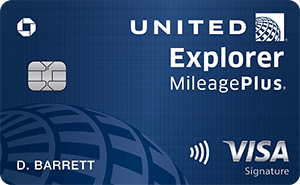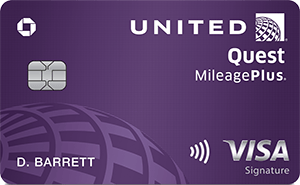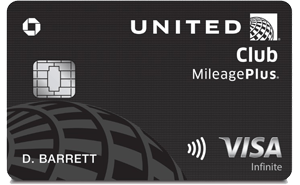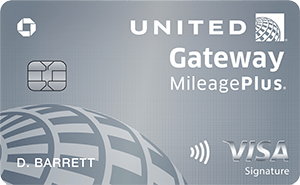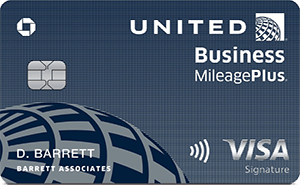The Guide to United Fare Classes

Many or all of the products featured here are from our partners who compensate us. This influences which products we write about and where and how the product appears on a page. However, this does not influence our evaluations. Our opinions are our own. Here is a list of our partners and here's how we make money.
Contrary to what one might assume, United Airlines has more classes than just first, business, premium economy and economy. In fact, each of those cabins is divided into multiple fare classes, all designated with a different letter.
While it might seem like alphabet soup, the airline can use fare classes to know how and when you booked your ticket and how to upgrade it — if that’s what you want to do.
Let’s take a look at the United fare class chart, how to find the fare class on your ticket and why it's smart to pay attention to your fare class in the first place.
What is a fare class on United?
All United cabins of service are divided into fare classes — sometimes called fare buckets — to keep track of the number of tickets sold on each flight as well as which seats are still available.
For example, if you’ve ever found a great deal on airfare and then the price went up before you could buy it, it’s likely because that first fare class sold out, even if there are still tickets available in that particular cabin.
» Learn more: United credit cards, perks to consider
Though there are similarities across airlines, each one labels its fare classes slightly differently. Here are United’s fare classes for each class of service on a paid ticket:
First/business class
Full fare: J.
High fare: C, D.
Discounted fare: Z.
Deep-discounted fare: P.
Premium Plus
High fare: O.
Discounted fare: A.
Deep-discounted fare: R.
Economy
Highest full fare: Y.
Full fare: B.
High fare: M, E, H, U.
Discounted fare: Q, V, W.
Deep-discounted fare: L, K, S, T.
Lowest discounted fare: G.
Basic economy: N (on domestic flights).
» Learn more: Valuable benefits of United Airlines credit cards
Note that tickets booked with miles come with their own separate set of fare classes.

How do I find my fare class on United?
When you’re shopping for a ticket on United, the fare classes are listed under each ticket type.
For example, in the screenshot below, the top flight from Chicago to Frankfurt, Germany, has the following fare classes: S in economy, R in premium economy and P in business. The bottom flight has the following fare types: S in economy, A in premium economy and D in business class.
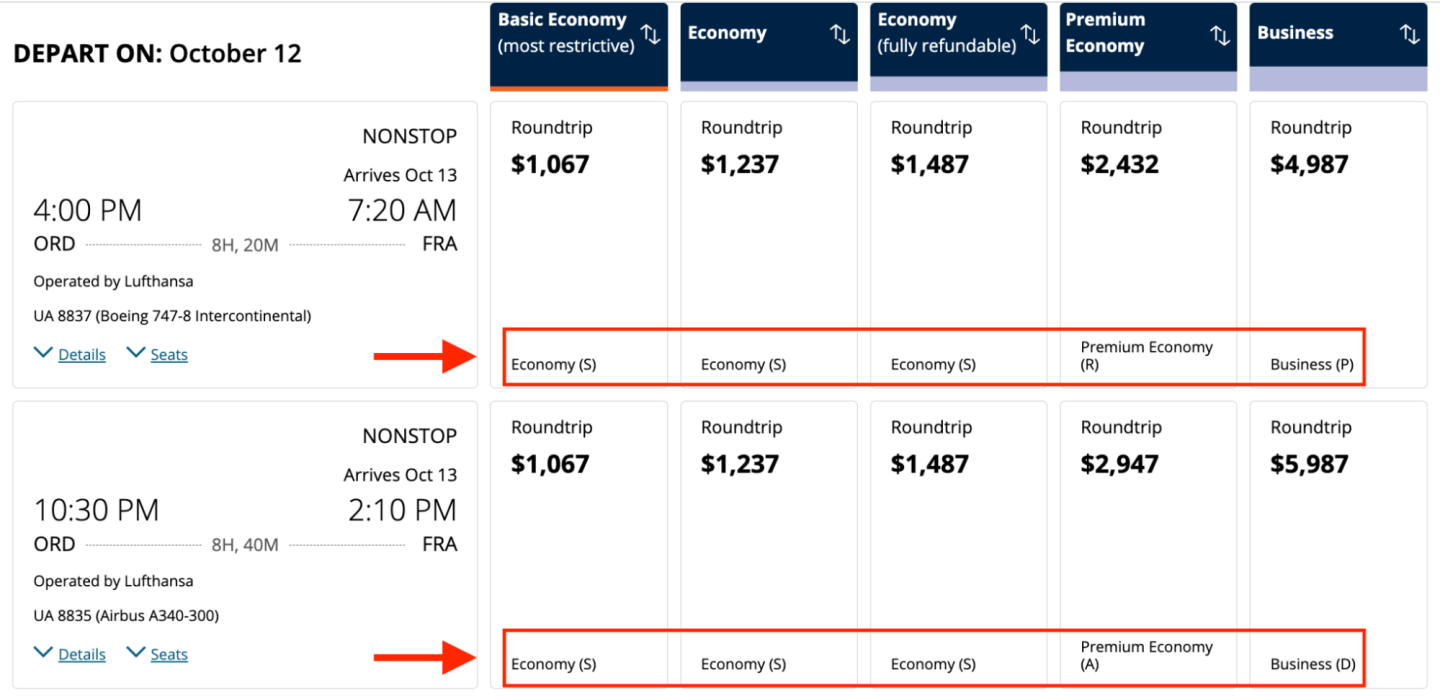
If you’re shopping for a flight on an online travel agency’s website, such as Expedia or Orbitz, you should be able to locate the fare class under “Details” once you select your flights but before you enter your credit card number.
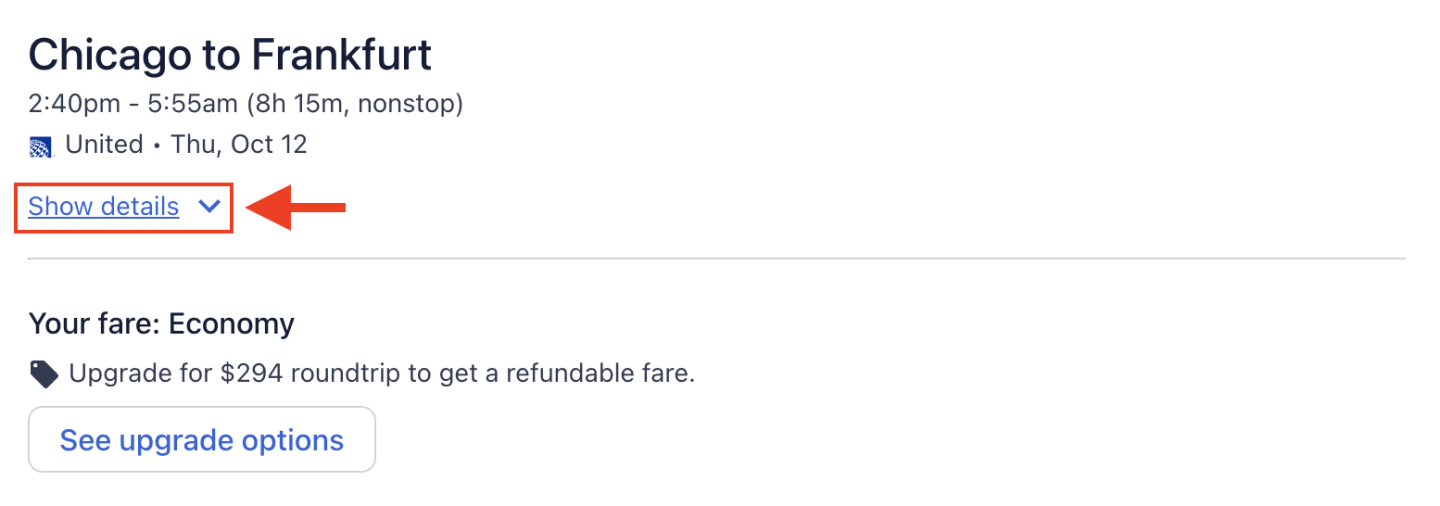
This ticket from Chicago-O'Hare to Frankfurt, Germany, has a fare class of S in the economy cabin.
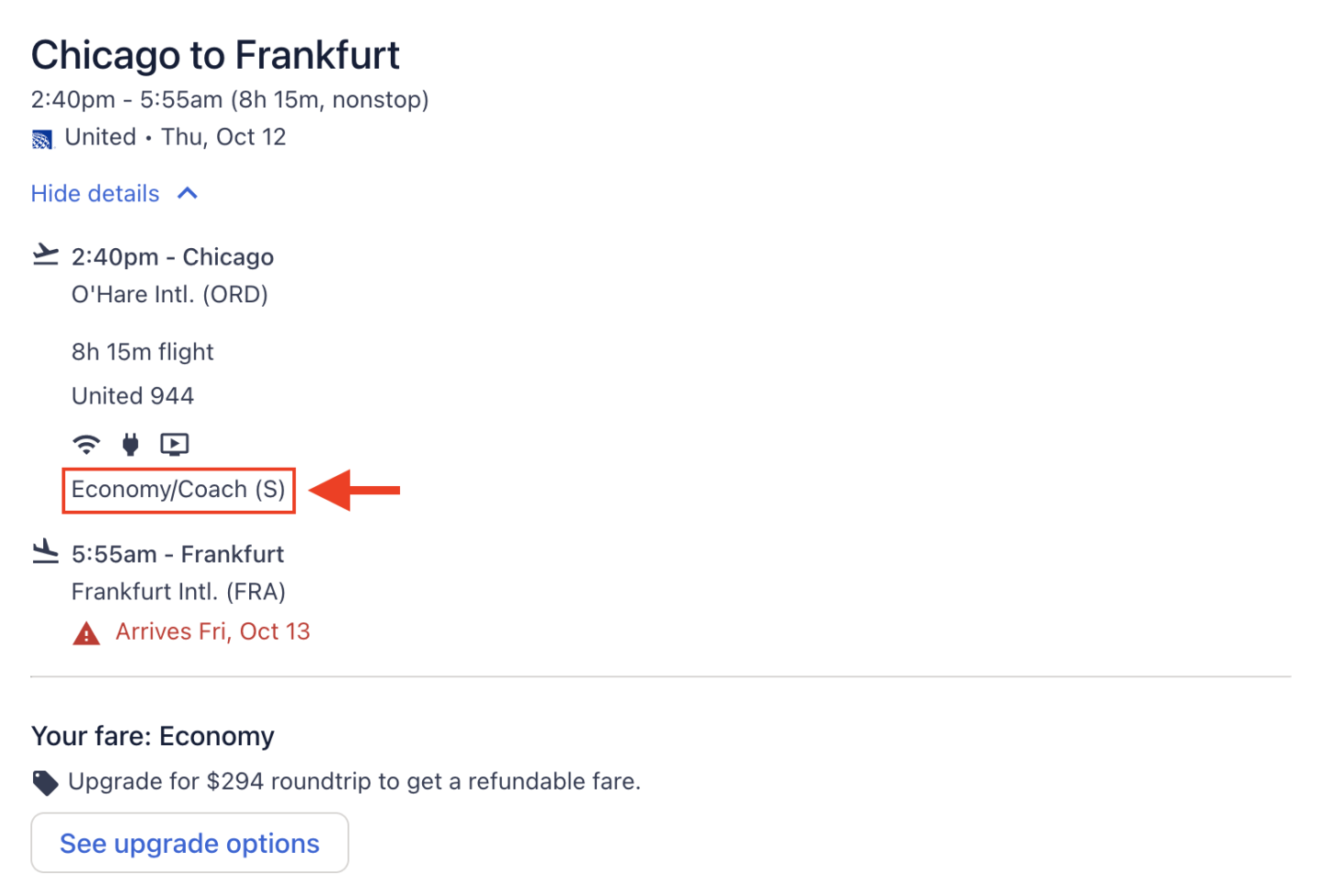
When possible, book your flights directly with the airline. This way, you avoid having to deal with a third-party booking site in case you need to change or cancel the flight or if there’s a cancellation by the airline.
Why should I pay attention to fare classes on United?
There are some good reasons to pay attention to which fare class you’re booking. For one, your fare class (specifically, the price) can determine how quickly you earn elite status and whether you’re eligible for an upgrade.
Elite status qualification
Passengers achieve elite status by earning a combination of Premier Qualifying Flights (PQF) and Premier Qualifying Points (PQP) earned. PQF are based on the flight segments completed. So a nonstop flight counts as one PQF while a flight with one stop will count as two PQF. Basic economy tickets are an exception because they don't earn any PQF.
PQP is comprised of the base fare, carrier imposed charges, seat purchases and paid upgrades. So, the more expensive your flight, the more PQP you earn, and the faster you can achieve elite status.
» Learn more: The guide to United Airlines Premier elite status
Upgrade eligibility
To be eligible for an upgrade, you’ll need to have booked in the right fare class for the type of upgrade you’re requesting.
Complimentary Premier upgrades
If you’re a MileagePlus Premier flyer, tickets booked in certain fare classes are eligible for instant complimentary Premier upgrades (available on select routes). For example, economy tickets booked in fare classes Y or B for all Premier members, and tickets booked in fare classes Y, B or M for Premier 1K members, qualify for immediate upgrades to the premium cabin at booking.
The following routes are eligible for complimentary Premier upgrades:
Continental U.S. (except premium transcontinental routes).
Hawaii from Los Angeles or San Francisco.
Alaska, Canada, Mexico, Caribbean and Central America.
Guam and Micronesia.
Outside of instant upgrades, you can increase your chances of getting a complimentary Premier upgrade when you book a higher fare class than a fellow Premier member at the same status tier.
MileagePlus upgrades
If you’re not an elite flyer with United, you still have the option to upgrade a flight with MileagePlus miles. Depending on the fare class, your Premier status level and your flight route, you might be asked for a cash co-pay on top of the miles redeemed.
For example, tickets in fare classes B, O or Y don’t include a cash component. Tickets booked in most other fare classes will require a cash co-pay.
PlusPoints upgrades
Premier Platinum and Premier 1K members receive PlusPoints that can be used to upgrade United flights. Platinum members receive 40 PlusPoints upon reaching their status tier, and 1K members get another 280 PlusPoints, totaling 320 PlusPoints toward upgrades.
United charges 40 PlusPoints for upgrades from economy to Polaris business class and 80 PlusPoints for upgrades from discounted economy to Polaris on long-haul flights. So, if your ticket’s fare class is S, T, L, K or G then you’ll need 80 PlusPoints for an upgrade to Polaris. Otherwise, you’ll just need 40 PlusPoints for your upgrade.
Additionally, if you’re a Premier 1K member, some fares make you eligible to skip the waitlist and confirm an upgrade right away, as long as your flight is on an eligible international route and is more than 30 days out. Those fares include:
From United Premium Plus to United Polaris business class: O, A and R.
From United economy to United Polaris business class: Y, B, M, E, U, H, Q, V and W.
From United economy to United Premium Plus: Y, B, M, E, U, H, Q, V, W, S, T, L and K.
When crediting miles to a partner program
Another time you should pay attention to fare classes is when you’re crediting a flight to a partner program. Say you’d rather earn miles with Air Canada Aeroplan, who is a Star Alliance partner of United, and you want to know the earning rates.
You’ll earn the following number of Aeroplan points and Status Qualifying Miles (SQMs) when crediting paid United flights to Aeroplan:
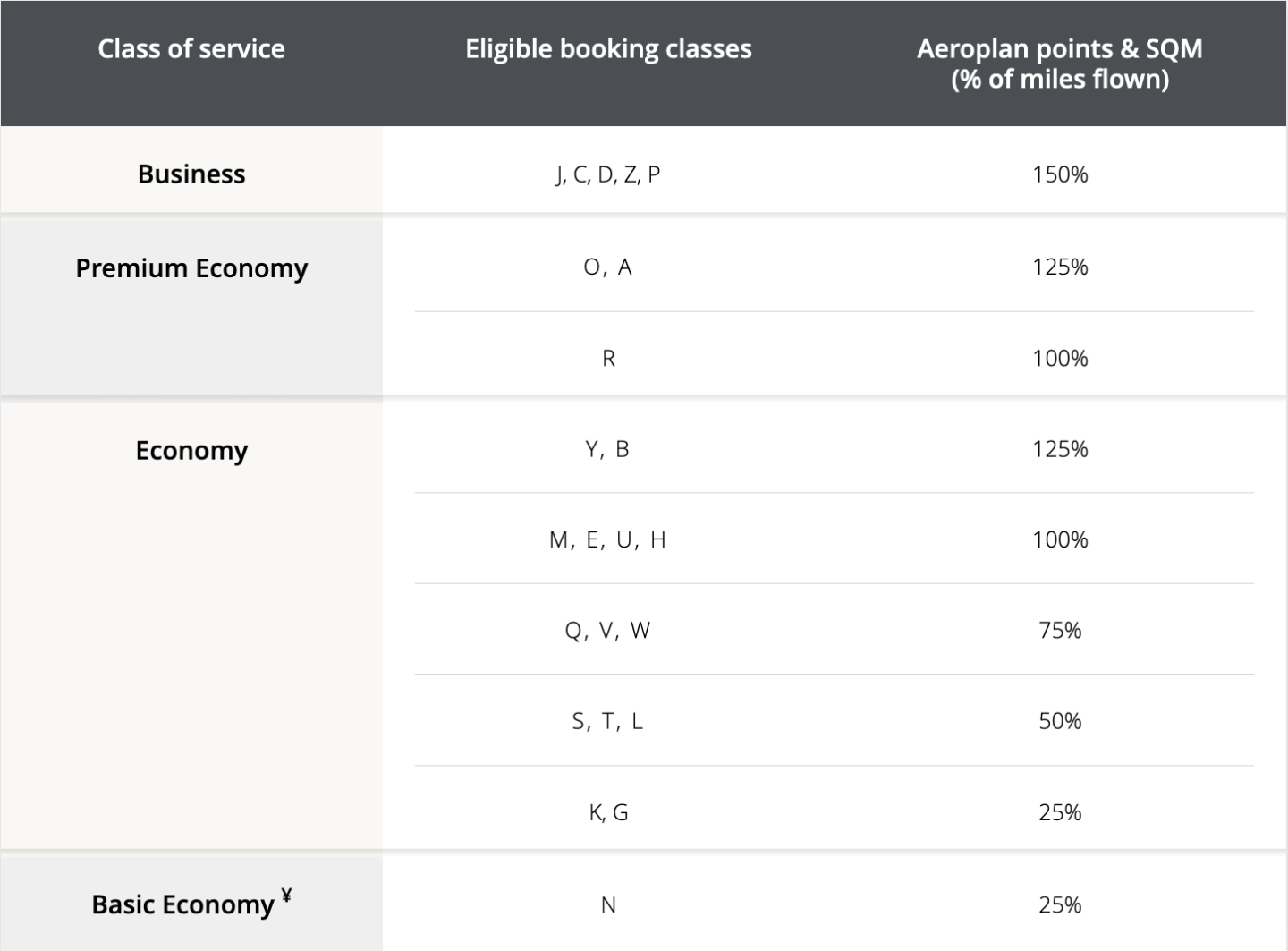
If you’re a member of multiple airline loyalty programs and can’t decide where to credit your flight, check out WhereToCredit, a website that shows you how many miles you’d earn in any frequent flyer program for a particular flight. This can help you make sure you're earning the highest possible number of redeemable miles.
Let’s say you’ve booked a United economy ticket in fare class V and want to know where to credit this flight. Go to the WhereToCredit website, select the airline and fare class and view the results.
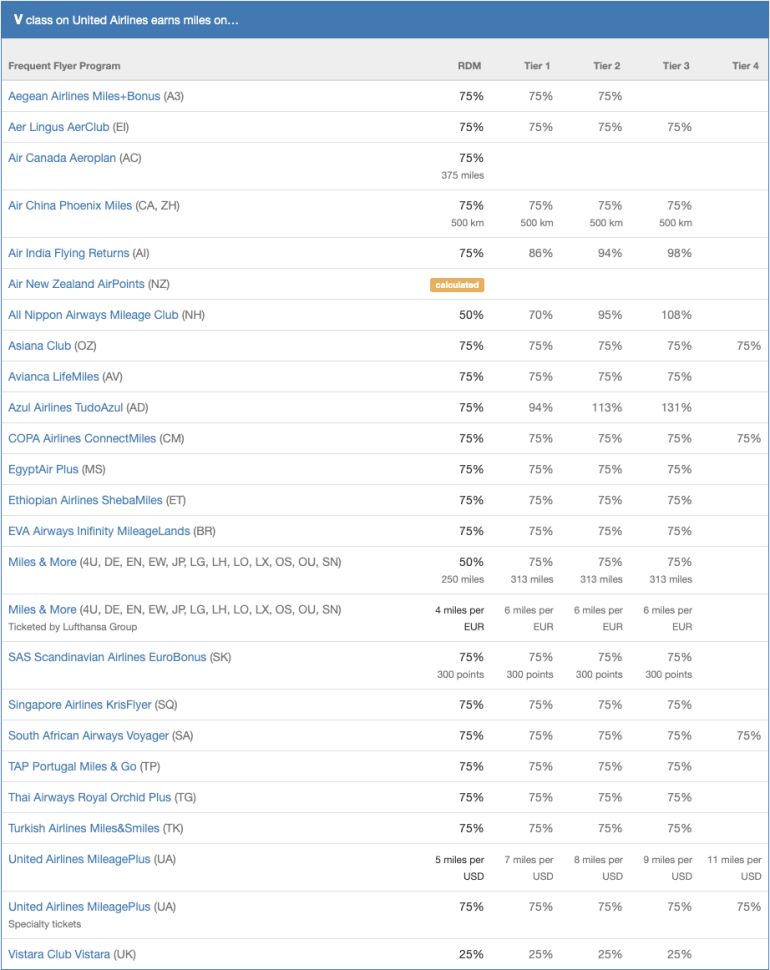
Based on the results, you’d earn 5 miles per base dollar spent on the ticket with United MileagePlus (as a general member), 50% of the flight distance with ANA Mileage Club and Miles & More and 75% with all the other partner programs, so you can take your pick of the programs earning more miles.
» Learn more: How to save money on United Airlines flights
How can I book specific fare classes on United?
Travelers often don’t care which fare class they book as long as the ticket price is low. However, if you’re chasing status or want to book an upgradeable ticket, there are ways to search for specific fare classes on United.
Go to United.com and select “Advanced search.”
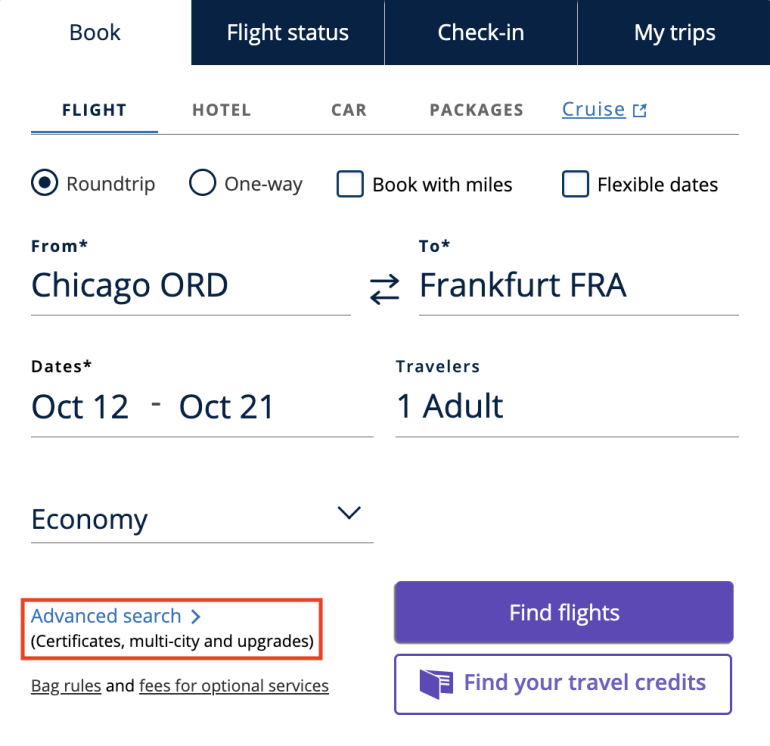
Enter your flight search details as usual and scroll down until you see a “Fare class” box. Fill in the fare classes you’re looking for and click on “Find flights.”
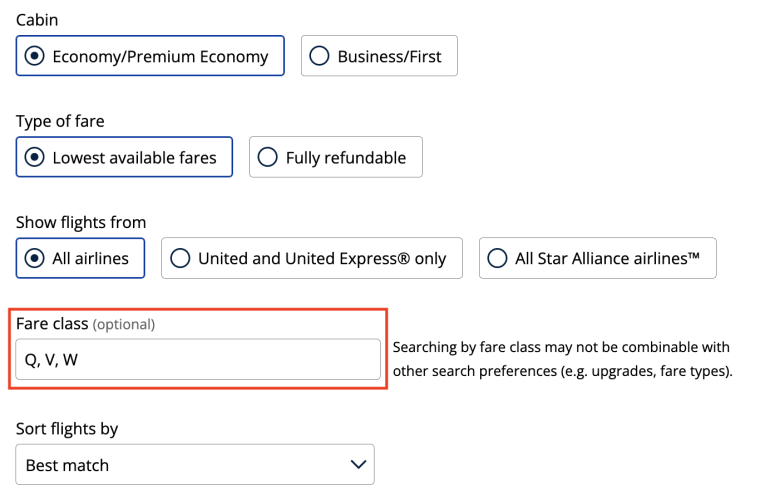
On the results page, you’ll see the regular search results for all other booking classes as well as a column with the requested fare classes.
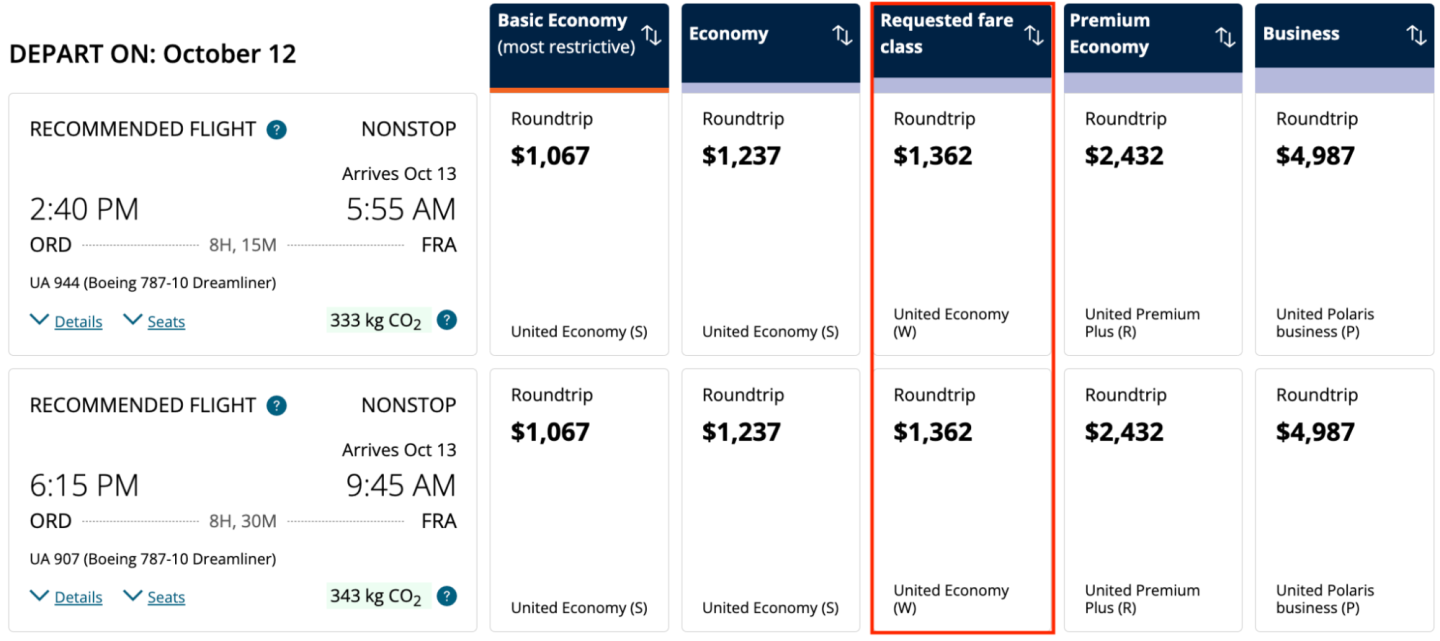
This way you can compare ticket prices and decide whether booking a specific fare class is worth it or not.
Book smarter: United credit cards
Secure the best earning rates and benefits for your United flight needs by purchasing your tickets with the right credit card.
Here are a handful of Chase United credit card options — or you can read NerdWallet analysis on which are the best.
$0 intro for the first year, then $95.
$250.
$525.
$0.
• 2 miles per $1 on United purchases.
• 2 miles per $1 at restaurants and hotels (when booked directly with hotel).
• 1 mile per $1 on all other purchases.
• 3 miles per $1 on United purchases.
• 2 miles per $1 at restaurants, select streaming services and all other travel.
• 1 mile per $1 on all other purchases.
• 4 miles per $1 on United purchases.
• 2 miles per $1 at restaurants and all other travel purchases.
• 1 mile per $1 on all other purchases.
• 2 miles per $1 on United purchases, gas stations and local transit and commuting.
• 1 mile per $1 on all other purchases.
• First checked bag free for you and one companion on your reservation.
• 2 United Club one-time passes each year.
• Credit of up to $100 every four years for TSA PreCheck, Global Entry or NEXUS.
• Priority boarding.
• No foreign transaction fees.
• First and second checked bag free for you and one companion on your reservation.
• $125 United purchase credit per year (good on airfare).
• Two 5,000-mile award flight credits per anniversary year.
• Credit of up to $100 every four years for TSA PreCheck, Global Entry or NEXUS.
• Priority boarding.
• No foreign transaction fees.
• First and second checked bag free for you and one companion on your reservation.
• Access to United Club airport lounges.
• Credit of up to $100 every four years for TSA PreCheck, Global Entry or NEXUS.
• Priority boarding.
• No foreign transaction fees.
• No foreign transaction fees.
Earn 50,000 bonus miles after you spend $3,000 on purchases in the first 3 months your account is open.
Earn 60,000 bonus miles and 500 Premier qualifying points after you spend $4,000 on purchases in the first 3 months your account is open.
Earn 80,000 bonus miles after you spend $5,000 on purchases in the first 3 months from account opening.
Earn 20,000 bonus miles after you spend $1,000 on purchases in the first 3 months your account is open.
If you seek more flexibility in redeeming miles for award flights, consider applying for a more general travel credit card instead. A more general travel credit card differs from an airline card in that you can book flights with multiple carriers, rather than reaping the benefits of staying loyal to a single brand.
The more high-end (or 'premium') the travel credit card, the more benefits you can enjoy, including airport lounge access or automatic elite status in certain programs. That said, a brand-specific airline card can net you benefits like waived baggage fees, which can have meaningful dollar value.
» Learn more: Is a United credit card worth it?
Final thoughts on United fare classes
The United fare class you’ve booked can make all the difference between qualifying for an upgrade or not, how much the upgrade is going to cost in miles or cash, and how many miles and segments toward elite status you’ll be earning.
United makes it easy to find your specific fare class before or after you book a flight. It's smart for United elites in particular to pay attention to fare classes, as booking the right one could make you more likely to score an upgrade.
How to maximize your rewards
You want a travel credit card that prioritizes what’s important to you. Here are our picks for the best travel credit cards of 2024, including those best for:
Flexibility, point transfers and a large bonus: Chase Sapphire Preferred® Card
No annual fee: Bank of America® Travel Rewards credit card
Flat-rate travel rewards: Capital One Venture Rewards Credit Card
Bonus travel rewards and high-end perks: Chase Sapphire Reserve®
Luxury perks: The Platinum Card® from American Express
Business travelers: Ink Business Preferred® Credit Card
on Chase's website
1x-2x
Miles50,000
Mileson Chase's website
1x-2x
Miles75000
Mileson Chase's website
1x-3x
Miles60,000
Miles


